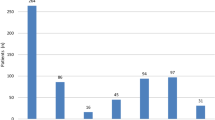Summary
The purpose of this article is to evaluate the incidence and to give a general review of the examination of the posterior ligament complex. At least ca. 8–10 % of all severe ligament injuries concern the posterior cruciate ligament, which means, that an estimated 4000–5000 Germans suffer a PCL rupture every year. Motor-vehicle accidents are the most common cause of the injury, but sports-related traumas (football, skiing) have increased in recent years. The high number of high-energy mechanisms involved (up to 90 %), cause ligament ruptures often to be associated with other injuries, especially fractures of the femur and tibia head. In polytrauma patients PCL ruptures are frequently recognized very late, because the possibility of this kind of injury is often not considered during the clinical examination. The same holds for the diagnosis of monotrauma patients. The initial step in the evaluation is to obtain a thorough history (including the mechanism of injury) and to perform a physical examination. The instability after a PCL rupture may present as an ACL rupture, because the anterior drawer test seems to be positive. The anterior/posterior drawer test must be assessed with other evaluation procedures to distinguish between anterior und posterior instabilities. The posterior sag sign, the quadriceps active test or the reversed pivot-shift may indicate a PCL rupture. A correct roentgenogram can reveal an avulsion of the tibia and can prove posterior instability due to a posterior translation of the tibia. A quantitative examination (clinical or X-ray) of the instability and the indication of combined injury of the posterior cruciate ligament and the posterolateral complex are necessary for the therapeutic decision (operative/conservative). A rupture of the PCL may occur occasionally as a result of a luxation of the knee (reduced spontaneously) before the medical evaluation. A thorough neurovascular examination is essential. Magnetic resonance imaging can be important to the diagnosis of an acute injury, but it is not essential for the choice between operative and non-operative treatment. Arthroscopy has been found to have a high degree of accuracy in the diagnosis of ligament ruptures of the knee, but it is still an operative treatment, so that it can only be used if an operation of repair or reconstruction is planned anyway. Before operative treatment of chronic complex instability, potential osseous abnormalities (varus morphotype) must be revealed; in case of uncertainty, an X-ray control is necessary.
Zusammenfassung
Die Zielsetzung dieser Arbeit ist, Umfang und Bedeutung der Diagnostik der Verletzungen des hinteren Kreuzbands (HKB) darzustellen. Aktuelle Schätzungen, gehen davon aus, daß zumindest 8–10 % aller Knie-Band-Schäden den dorsalen Bandapparat betreffen. Hiernach müssen alleine in Deutschland 4000–5000 HKB-Rupturen (ohne Berücksichtigung einer evtl. noch bestehenden Dunkelziffer) behandelt werden. Viele davon sind Folge von Rasanztraumen (30–90 %), entsprechend hoch ist der Anteil an weiteren Verletzungen. In der Praxis werden HKB-Rupturen gehäuft bei Tibiakopf- und Femurschaftfrakturen gefunden, prinzipiell sind jedoch alle Kombinationen möglich. Bei Mehrfachverletzten werden Bandverletzungen häufig verspätet erkannt, da andere Verletzungen offensichtlicher sind und eine differenzierte (wiederholte) klinische Untersuchung unterbleibt. Die korrekte Diagnose wird häufig versäumt, weil zu selten an die grundsätzliche Schädigungsmöglichkeit der dorsalen Bandstrukturen gedacht wird. Eine zielorientierte klinische Untersuchung bei entsprechender Anamnese (Anpralltrauma, Hyperflektionsmechanismus) ergänzt durch die Röntgennativdiagnostik grenzt die Schädigungsmöglichkeiten ein. Jede vordere Schublade ist bis zum Beweis des Gegenteils dabei zunächst als mögliche dorsale Instabilität zu werten. Der Schubladentest ergänzt durch den dorsalen Durchhang (posterior sag) führt zur Diagnose. Therapeutisch notwendig ist die Abgrenzung einfacher sagittaler von komplexen (dorsomedial bzw. dorsolateral) Verletzungen. Seitenbandinstabilitäten, “reversed pivot shift”, Rotationsschubladen und/oder eine Translation von mehr als 10 mm lassen auf kombinierte Verletzungen schließen. Eine klinische oder radiologische quantitative Stabilitätsbeurteilung ist zur differenzierten Therapieplanung (Operation/konservativ) notwendig. Eine qualitativ gute Kernspintomographie kann die präoperative Planung durch Ausschluß bzw. Nachweis von Begleitverletzungen bei akuten Verletzungen erleichtern. Angiologische und neurologische Untersuchungen sind obligat durchzuführen, Mit Gefäßverletzungen ist vor allem bei Luxationsmechanismen zu rechnen. Vor der operativen Therapie chronischer Instabilitäten ist eine pathologische Beinachse (Varusdeformität) ggf. radiologisch auszuschließen. Die Arthroskopie als invasiver Eingriff ist als Teil einer operativen Therapie sinnvoll, zur alleinigen Diagnostik steht der Nutzen nicht in Relation zu Aufwand und Risiken.
Similar content being viewed by others
Author information
Authors and Affiliations
Rights and permissions
About this article
Cite this article
Hochstein, P., Schmickal, T., Grützner, P. et al. Diagnostic and incidence of the rupture of the posterior cruciate ligament. Unfallchirurg 102, 753–762 (1999). https://doi.org/10.1007/s001130050477
Published:
Issue Date:
DOI: https://doi.org/10.1007/s001130050477




